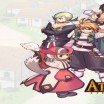Nostalgia Fever – Atelier Iris: Eternal Mana

Today I’ll talk about another PS2 game I personally enjoyed in my younger days, which is called Atelier Iris: Eternal Mana. It’s a unique game series that emphasizes on creating items to further your quest through the use of spirits known as Mana and the power of alchemy.
But what is alchemy? A long time ago, it was a philosophical debate on whether or not people had powers to create elixirs of eternal life or turning lead into gold. In modern times, it can be compared to chemistry and other sciences. But in the fantasy genre it is still a big thing, from anime to video games. And I’ll say right here; Fullmetal Alchemist has one of the best stories I’ve seen in anime/manga.
But I digress from this week’s topic; another old PS2 game that introduced me to a very long running game series in Japan, though I didn’t know of it at the time. Then again, this game is part of a specific niche of JRPGs lovers. Lucky for me, I’m a niche guy.
Atelier Iris: Eternal Mana is one of those RPGs that runs on a specific gimmick to help it out. In this case, it’s alchemy, and the player has the chance to make items to better the grand adventure they’re in.
You play as Klein Kiesling (the orange-yellow haired man from the picture above), a wandering alchemist with a wood spirit, or Mana, named Popo (green fairy at the side), as he stumbles into the town of Kavoc. He becomes a Galgazit (guild name for a group of monster hunters) and helps out his new friend/love interest Lita Blanchimont (brown haired girl) in this job while looking for alchemy items and perfecting his art. Klein’s alchemy skills are put to the test as he learns more about Lita’s past and vows to save her and the world from an evil alchemist named Mull.
There are two big factors in the gameplay, with the obvious one being the turn-based fighting. Each character has their own unique skills and weapons to use, and can even level up their skills to make them stronger with each level up. Klein getting special mention in that he can use and create alchemy items on the fly. He’s not the strongest fighter, but he’s more of a traditional mage character, which is unique since he’s the main protagonist. To win hard battles or easy ones, it requires a bit of strategy of taking account to your player’s skill set and/or weaknesses from Klein’s item collection. There are six character in total to play, but switching members during battle is allowed, and everyone gets experience.
The other factor is the item crafting. Some times can be made only with elements, which are collected when you deconstruct certain items on the world map. Like if there’s a small tree or bush in your way, you can Element Extract it and collect a set amount of Wood Element. You can then use that Wood Element, either by itself or with other collected elements, to make an alchemy item that will help you in battle.
For other items, either for quest purposes or expanding the stores around the world, you synthesize items that you collect from dungeons and enemy remains. Depending what kind of items you use, it may affect the quality of the item and how effective it is. The quality of the finished product in synthesizing might even change it entirely and make a new item.
You don’t find just items by exploring though. You can also find Growloons; big black and white balloon monsters that summon more monsters and are encouraged to be destroyed for profit and reward. There’s also the chance to find Mana to join your party that can help you in three different ways. The first is conduits in using the elements for synthesis (meaning, only the Wood Mana Popo can use the Wood Element). The second is to use some of their field skills to help your journey, such as summoning the Stone Mana to be your step-ladder. And finally, they can be equipped to your party members during battle, increase their stats and grant bonus points to level up certain skills.
Thinking back, the graphics were quite different from what I remember, and 3D world exploring wasn’t easy when you had 2D map and sprite graphics. That’s where I see the game failed a bit, despite its vibrant colors. Character and story-telling wise, the game relied a lot on anime slap-stick comedy, like girls who get mad at “dense” boys over their feelings. But that also means that it provides some genuinely funny moments and commentary. And the music blew me away from its lighthearted comedic pieces, to the soft and sad tunes, and the catchy boss battles. Simply put, every musical piece fits with the mood.
Finally, there’s an in-game tutorial appropriately called “Popo’s Fourth Wall Lecture Series”, where the Popo and the rest of the cast that “guest star” break the fourth wall and explain about new gameplay elements introduced and how to use them. These can be re-watched any time at the player’s convenience as to remind them of what to do, or if they want to laugh at certain jokes that happened during the lectures.
I hold Atelier Iris: Eternal Mana in good graces, because it introduced me to the Atelier series in general. I believe it is one of the most creative uses of item making, which was only refined over the years with more games. Following this game over the years were sequels to Atelier Iris, the two Mana Khemia games, and the Arland Trilogy (Rorona, Totori, Merumu) for the PS3, with even more games after that. I may be due to replay it at some point just to see how different Alchemy was from before Atelier Totori.










Leave a Reply